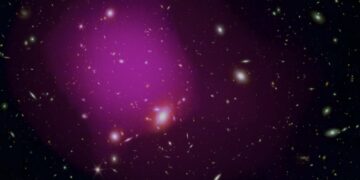Astronomers have just unveiled a treasure trove of cosmic history — the largest and deepest sample of galaxy groups ever observed, thanks to the James Webb Space Telescope (JWST). Detecting nearly 1,700 galaxy groups stretching from 12 billion years ago to just 1 billion years ago, this discovery reshapes our understanding of how galaxies form, grow, and interact across time. It’s a monumental step that offers unprecedented insights into the evolution of the universe’s largest structures.
The Discovery — The Largest Galaxy Group Catalog Ever Compiled
The James Webb Space Telescope’s COSMOS-Web survey has revealed a colossal catalog of galaxy groups, reaching further and deeper than ever before.
Astronomers have detected 1,678 galaxy groups and proto-clusters, mapping the evolution of cosmic structures across a staggering 12 billion-year timeline. Led by Ghassem Gozaliasl of Aalto University, the team used JWST’s powerful infrared capabilities to spot galaxies a billion times dimmer than what the human eye can detect, capturing faint structures dating back to when the universe was still a cosmic toddler.
These detections are critical because galaxy groups represent the most common environment for galaxies to exist. Their evolution influences everything from star formation to black hole growth. By building the largest and deepest sample ever, astronomers have unlocked a long-lost chapter in the universe’s family album.
This monumental catalog doesn’t just break records — it lays the groundwork for decades of research into the life cycles of galaxies and the architecture of the cosmos.
The Role of Galaxy Groups — Cosmic Families in Action
Understanding galaxy groups is key to understanding the universe itself — and JWST’s findings shed new light on this cosmic dynamic.
Galaxy groups are the cosmic families where most galaxies live, interact, and evolve, rather than existing alone in isolation. Our own Milky Way belongs to a modest galaxy group called the Local Group, alongside Andromeda and dozens of smaller galaxies. Studies show that groups typically contain three to a few dozen galaxies, while larger clusters can house thousands.
Inside these groups, galaxies merge, collide, and exchange gas, dramatically reshaping their forms and star-making activities. Importantly, these interactions fuel the growth of the Brightest Group Galaxies (BGGs) — the massive, dominant galaxies at the groups’ centers.
By capturing images of galaxy groups at different cosmic times, JWST allows scientists to track how these cosmic families formed and evolved, shedding light on the cosmic web’s intricate history.
Revealing the Evolution of the Universe’s Structure
The newly compiled catalog doesn’t just show where galaxies were — it shows how they changed over billions of years.
The discovery highlights how galaxies transitioned from chaotic, star-forming structures to organized, quenched formations over time. In the early universe, galaxies appeared irregular, teeming with new star birth. Closer to our time, galaxies show more symmetrical shapes, like spirals and ellipticals, and star formation is largely quenched.
This evolution is a key narrative in understanding galaxy lifecycles. It tells us how early chaotic mergers and interactions gave rise to the structured galaxies we see today. Moreover, it reflects underlying processes like dark matter accumulation, black hole feedback, and gas heating in the intergalactic medium.
With a clearer cosmic timeline, researchers can now build more accurate models of galaxy evolution, star formation history, and cosmic structure growth.
James Webb Space Telescope’s Breakthrough Capabilities
The stunning success of this survey rests entirely on the unique abilities of the James Webb Space Telescope.
JWST’s powerful infrared sensitivity and unprecedented resolution made this discovery possible, peering farther and deeper than any previous observatory. Operating since 2022, JWST can detect galaxies that are a billion times fainter than visible to the human eye, capturing light emitted during the universe’s earliest stages.
Unlike its predecessors, JWST can penetrate thick cosmic dust and reveal the hidden, ancient universe. COSMOS-Web’s deep field survey combines JWST’s capabilities with wide sky coverage, allowing astronomers to systematically map galaxy groups at varying distances and epochs.
These technological breakthroughs have made it possible to transform theoretical models of early cosmic structures into observable realities, bridging the gap between predictions and direct evidence.
Why This Discovery is So Important
Beyond the immediate thrill of record-breaking numbers, this discovery holds profound significance for cosmic science.
The newly detected galaxy groups offer the most complete observational record yet of how large-scale cosmic structures formed and evolved. Prior to JWST, surveys like Hubble’s GOODS and COSMOS surveys could only glimpse part of the picture — now, astronomers have a continuous record from 12 billion years ago onward.
This complete dataset allows scientists to address critical questions: How did dark matter shape galaxy distribution? When and why did star formation quench? How did the earliest galaxy groups grow into today’s superclusters?
Conclusion: A New Family Album of the Universe
Thanks to the James Webb Space Telescope, astronomers now hold a cosmic family album spanning nearly 90% of the universe’s history. By capturing 1,678 galaxy groups across 12 billion years, scientists have mapped the evolution of the universe’s largest structures with unprecedented depth and clarity.
Reference:
Greta Toni et al, The COSMOS-Web deep galaxy group catalog up to z=3.7, Astronomy & Astrophysics (2025). DOI: 10.1051/0004-6361/202553759



















